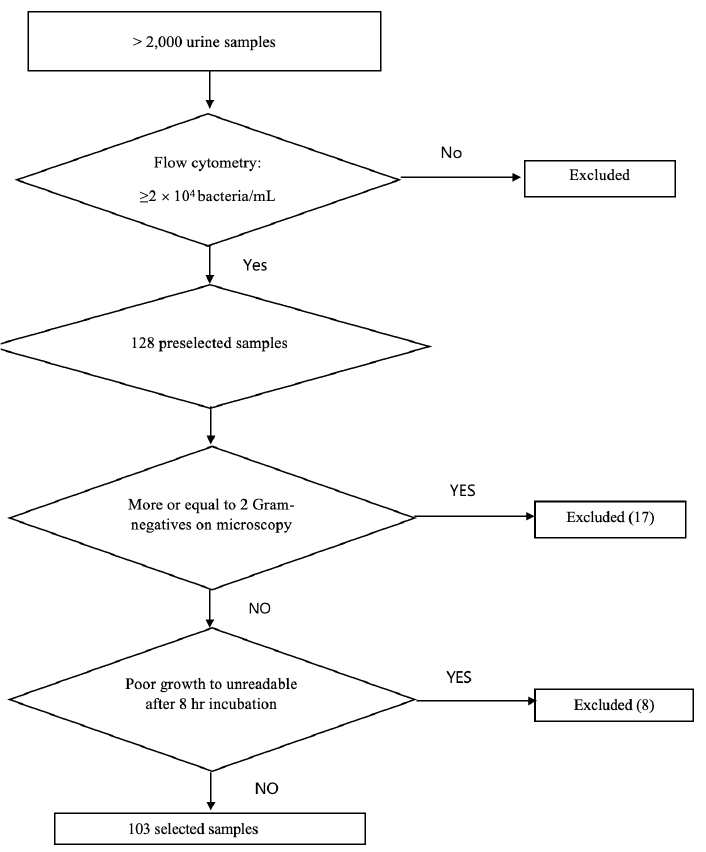Abstract
Background: The rapid antimicrobial susceptibility testing (AST) performed on urine samples would guide the adequate choice of antibiotics for obtaining better treatment outcomes in patients. Our study aimed to evaluate the performance of the modified-EUCAST (European Committee on Antimicrobial Susceptibility Testing) rapid direct AST on urine samples.Methods:From <2,000 urine samples, a total of 128 urine samples containing bacterial counts of ≥2 × 104 CFU/mL with a uniform bacterial shape were initially included based on flow cytometry (Sysmex UF-1000i, Japan) and Gram staining, respectively. A total of 103 samples showing the presence of Enterobacteriaceae were finally selected in this study. The urine samples were directly inoculated on Mueller-Hinton agar, which was used in the current EUCAST rapid direct AST on blood samples. The size of the growth inhibition zones around antimicrobial disks was measured using a digital scanner (BIOMIC vision analyzer, Giles scientific, USA) and further confirmed by visualization with naked eyes after incubation for 4, 6, and 8 hours. The AST interpretations were compared to those of the conventional VITEK 2 AST system (bioMérieux, France) and the discrepancies between both tests were confirmed with the E-test.Results: The antibiotics, namely ampicillin, cefazolin, aztreonam, ceftazidime, cefotaxime, cefoxitin, cefepime, gentamicin, ciprofloxacin, and cotrimoxazole showed excellent correlations with modified-EUCAST rapid direct test and conventional ASTs with >0.75 weighted kappa values. The categorical agreement of the rapid direct AST was 1,442 (93.3%), with 76 (4.9%) minor error, 9 (0.6%) major error and 18 (1.2%) very major error, implicating the reliability of this method for clinical application.Conclusion: Performing the modified-EUCAST rapid direct AST on urine samples can predict reliable AST results within 8 hours. The rapid direct AST can help the physicians to initiate adequate antimicrobial treatment for urinary tract infections.
Keywords
Anti-bacterial agents Antimicrobial Susceptibility Testing Rapid methods
Figures & Tables

Fig. 1. Flowchart of urine samples selection.
Figures & Tables
Table 1. AST performance of modified-EUCAST rapid direct and conventional AST methods
| Antimicrobial agents | Modified-EUCAST rapid direct AST | Conventional AST | Unweighted kappa (95% CI) | Weighted kappa (95% CI) | ||||
| S | I | R | S | I | R | |||
| Ampicillin | 12 | 3 | 88 | 12 | 0 | 91 | 0.83 (0.77 - 1) | 0.89 (0.77 - 1) |
| Piperacillintazobactam | 91 | 8 | 4 | 86 | 8 | 9 | 0.66 (0.47 - 0.83) | 0.68 (0.50 - 0.86 ) |
| Cefazolin | 44 | 0 | 59 | 41 | 0 | 62 | 0.90 (0.81 - 0.99) | 0.90 (0.81 - 0.99 ) |
| Aztreonam | 65 | 5 | 33 | 67 | 0 | 36 | 0.84 (0.74 - 0.94 ) | 0.89 (0.80 - 0.97 ) |
| Ceftazidime | 61 | 14 | 28 | 69 | 1 | 33 | 0.74 (0.62 - 0.85 ) | 0.84 (0.75 - 0.92 ) |
| Cefotaxime | 50 | 6 | 47 | 54 | 3 | 46 | 0.89 (0.81 - 0.97) | 0.93 (0.876 - 0.99) |
| Cefoxitin | 77 | 3 | 23 | 70 | 8 | 25 | 0.76 (0.63 - 0.88 ) | 0.86 (0.78 - 0.94) |
| Cefepime | 79 | 0 | 24 | 80 | 6 | 17 | 0.73 (0.59 - 0.88 ) | 0.80 (0.67 - 0.92 ) |
| Ertapenem | 100 | 2 | 1 | 98 | 1 | 4 | 0.49 (0.18 - 0.79 ) | 0.60 (0.29 - 0.92) |
| Imipenem | 99 | 2 | 2 | 93 | 6 | 4 | 0.40 (0.08 - 0.73) | 0.48 (0.12 - 0.83) |
| Gentamicin | 75 | 1 | 27 | 75 | 1 | 27 | 0.93 (0.85 - 1) | 0.95 (0.89 - 1) |
| Amikacin | 101 | 1 | 1 | 103 | 0 | 0 | - | - |
| Ciprofloxacin | 34 | 21 | 48 | 45 | 10 | 48 | 0.76 (0.66 - 0.87 ) | 0.85 (0.78 - 0.92) |
| Cotrimoxazole | 56 | 1 | 46 | 57 | 0 | 46 | 0.90 (0.82 - 0.99 ) | 0.91 (0.83 - 0.99) |
| Tigecycline | 96 | 0 | 7 | 92 | 2 | 9 | 0.52 (0.26 - 0.77) | 0.55 (0.29 - 0.82 ) |


